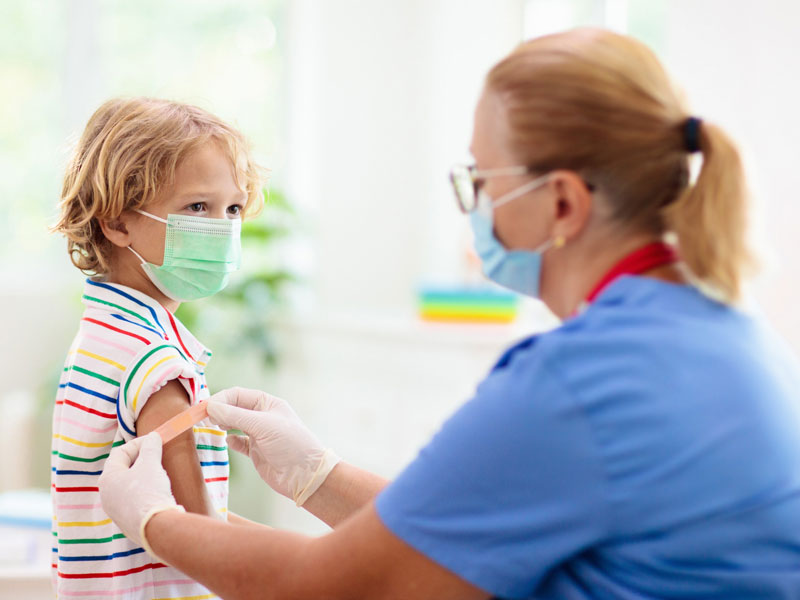Kindergarteners’ Vaccination Rates Continue to Decline
Rates Hold Steady for Toddlers
Jan. 19, 2023, 8:55 a.m. News Staff — A new report shows that for the second year in a row, national vaccination rates for some diseases fell by roughly 1% among kindergarten. The report highlights the crucial role of family physicians in educating patients, work that is made easier by resources from the AAFP.

According to the findings, published Jan. 13 in the CDC’s Morbidity and Mortality Weekly Report, coverage with two doses of measles, mumps and rubella vaccine, and with state-required doses of vaccines for polio, varicella, and for diphtheria, tetanus and acellular pertussis was about 93% for the 2021-22 school year, down from 94% in the previous school year and 95% in 2019-20, when most children were vaccinated before the start of the COVID-19 pandemic.
The report’s authors estimated that the decline represents nearly 250,000 children who may not be protected against measles and other infectious diseases. At least 85 cases of measles has been reported in an ongoing measles outbreak in Ohio, mostly in unvaccinated children; more than 20 cases were reported in an outbreak in Minnesota last fall.
Coverage Down, Exemptions Up
National vaccination coverage rates for the DTap, MMR, polio and varicella vaccines were 93.1%, 93.5%, 93.5% and 92.8%, respectively — all decreases from the 2020-2021 school year.
And overall, 2.6% of kindergartners had an exemption for at least one state-required vaccine, up from 2.2% in the previous school year.
Story Highlights
Perhaps most concerning was the continued decline in rates for the MMR vaccine. Nationwide, 3.9% of nonexempt kindergarteners were not fully vaccinated against MMR, the lowest rate since the 2013-14 school year.
Thirty states reported that COVID-19 continued to impact childhood vaccination coverage, mostly through reduced access, as well as through vaccination grace period extensions or provisional enrollment policies.
The authors suggested steps that could help reverse the downward trend, including identifying schools or communities that have low vaccination rates, enforcing school vaccination requirements, holding school vaccination clinics and following up with unvaccinated students.
Toddler Immunization Rates Hold Steady
For younger children, meanwhile, some findings were more encouraging. Results from a separate study also published in the Jan. 13 MMWR indicated that in children born during 2018 and 2019, coverage rates for most vaccines by age 24 months remained similar or higher compared with children born during 2016 and 2017, while the percentage of children who received no vaccinations decreased.
Among children born in 2018 and 2019, over 90% had received at least one dose of the MMR and varicella vaccines, and at least three doses of hepatitis B and polio vaccines, Coverage rates for at least two doses of hepatitis A and influenza vaccines were considerably lower, but still higher than for children born in 2016 and 2017.
At the same time, though, the study found that vaccination coverage declined for children who lived in rural areas or below the federal poverty level during the pandemic. The authors also noted that the proportion of children who were unvaccinated by age 24 months was eight times higher for uninsured children compared with those who had private insurance.
The authors suggested strategies including strong recommendations from health care professionals, reviewing immunization histories and advocating for vaccines during every health care encounter, and addressing parents’ vaccine hesitancy.
Increase Vaccination Confidence With AAFP Resources
Patients turn to family physicians as highly trusted sources of medical information, and the AAFP has a wealth of materials to help members offer guidance about vaccines. These include
- a free on-demand CME course on improving vaccine confidence;
- a patient education infographic that explains the benefits of childhood vaccinations;
- fact sheets to help members talk with parents, build confidence in vaccines and explain the vaccine safety system;
- guidance on vaccines for COVID-19 and influenza; and
- patient materials on COVID-19 vaccines for younger children, as well as on other childhood vaccines and preventive services at familydoctor.org.
Additional resources are available on the Academy’s Immunizations and Vaccines webpage, including the latest information on the CDC’s 2023 childhood, adolescent and adult immunization schedules, which are expected to be made public in February.